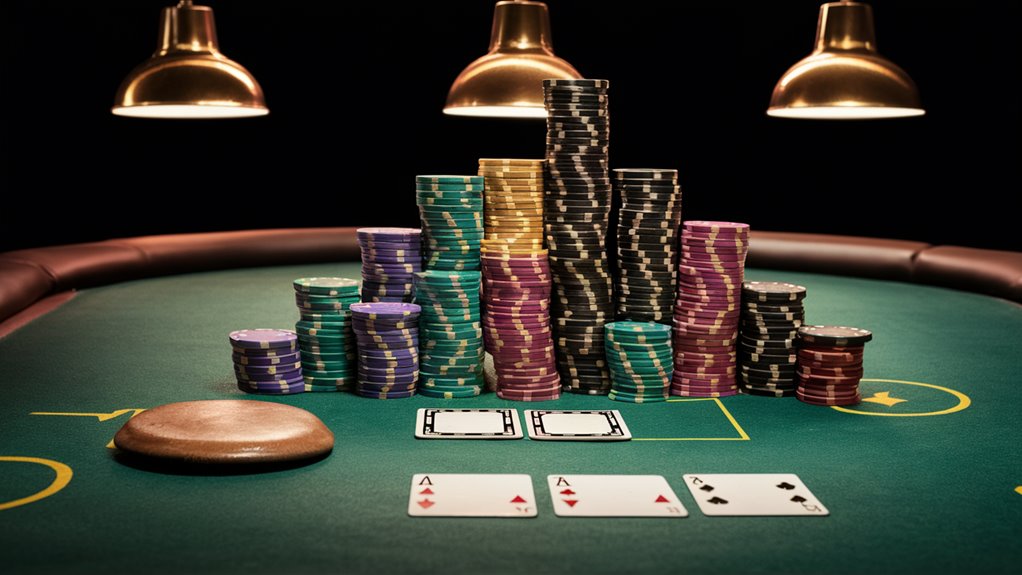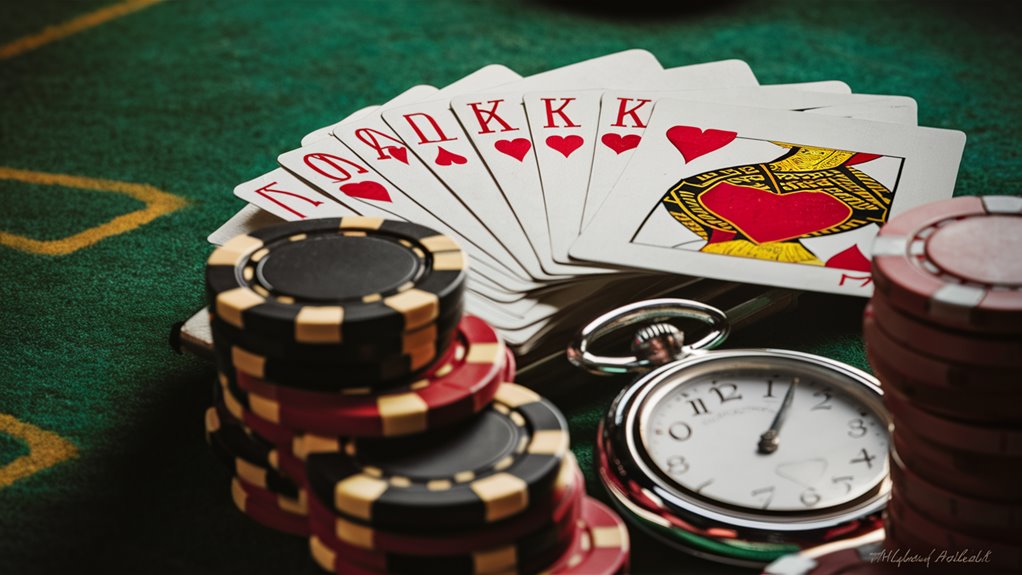Play Poker: Learn the Rules and Win More

Getting good at poker means knowing the key rules and playing in a clever way to make good money. This guide tells all you need to win at the table.
Main Hand Rankings
A Royal Flush is top in poker hands, then comes Straight Flush, Four of a Kind, Full House, Flush, Straight, Three of a Kind, Two Pair, One Pair, and High Card. Knowing these is key to making smart choices.
The Power of Position
Your spot at the table really changes your chance to win. Being in a late place lets you see what others do and act in a strong way. If you are in an early place, pick the best starting hands and play safe. Getting how to use your place makes you much stronger.
How to Bet and Manage Money
Know the three main betting types:
- No-Limit Hold’em: You can bet as much as you like
- Pot-Limit: You can’t bet more than the pot’s size
- Fixed-Limit: Bet amounts are set
Keep your money safe by having 20-30 buys for your game, to last longer and make more.
Advanced Skills and Knowing Your Opponents
Learn to:
- See patterns
- Get what body signs mean
- Change your bets
- Think about ranges
Change how you bet to keep others guessing while you use what you know about them. Top players use these skills.
Basic Hand Rankings
Know Poker Hand Rankings Well
Basics of Poker Hands
Knowing poker hand rankings is a must for good play, telling who wins each round. It is very important to learn them well to play well.
Top Hand Rankings (Best to Worst)
Royal Flush
The best hand is the Ace, King, Queen, Jack, and Ten, all in the same suit—the top of the game.
Straight Flush
Five cards in a row of the same suit make this strong hand, just under the royal flush in the game order.
Four of a Kind
Four same cards and any fifth card make this.
Full House
Three and two matching cards make this hand.
Flush
Any five cards of the same suit make a flush.
Straight
Five cards in order but different suits make a straight.
Three of a Kind
Three same cards plus two different ones.
Two Pair
Two groups of same cards plus one different one.
One Pair
One set of matching cards and three different cards.
High Card
If no other hand, the top card counts.
Why Knowing This Matters
Good players know hand ranks fast, leading to better and less costly plays.
Different Poker Games
All About Poker Types
Common Poker Games
Texas Hold’em is the main type, with two hidden cards and five shared ones to make the best hand. This style is key for big games and online play, making it a must-learn.
Omaha Poker has more complex rules, giving four hidden cards and needing two of these and three shared ones for the hand. This brings more plays and bigger bets than Hold’em.
Old-School Games
In Seven-Card Stud, you get seven cards on your own over different rounds, with no shared cards. You must watch the seen cards and plan your bets well through five bet rounds.
Five-Card Draw is quick and easy to learn. You get five cards and can swap them once, making good guessing and tricks key.
Special Poker Types
Razz flips poker: the lowest hand wins. It is played like Seven-Card Stud, making you think differently about hands.
Caribbean Stud pits you against a dealer with elements from poker and other table games. Chinese Poker has you make several winning hands at once, adding unique rules and strategy needs.
How to Grow Your Skills
Texas Hold’em is a good start: learn the basic ideas and how to bet. Then try other types to understand more games and get better at poker.
Betting Types
Poker Betting Types
Basic Betting Forms
Poker betting types are central to each game, with three main styles shaping how you play and plan. Each style brings different chances and tests for any player.
No-Limit Betting
No-limit poker, the most open form, lets you bet all you have at any time. This freedom lets you play in bold ways, good for those who know how to play to their edge.
Pot-Limit Rules
Pot-limit play caps bets to the pot’s size. This style offers a mix of control and deep play, very liked in Omaha games. It sets a natural cap while still letting you plan complex plays.
Set-Limit Betting
Fixed-limit play has set bet sizes, often double in later rounds. This style is common in old stud games and some hold’em games. It’s great for new players by cutting risk and stressing basic planning over bet tricks.
What Each Style Means
Each betting type needs its own skills:
- No-limit: Needs top hand reading and bet sizing
- Pot-limit: Asks for smart aggression and pot control
- Fixed-limit: Values place play and starting hand picks
Knowing these styles helps you master different poker games and build a full set of skills.
Position and Table Play
Know Your Table Place in Poker

How Position Works
Your table spot shapes your game plan by your seat order. Late players (near the dealer button or cutoff) have a key edge by acting last, seeing how others play first. This spot lets you pick from more hands and acts strong against those before you.
Adjusting By Position
Early players, like those right after the dealer, need to play it safe with top hands only. This keeps you safe when you can’t see what others will do. Middle players must mix careful play with some bold moves, watching how the table feels.
Using Your Place Right
Winning means looking at how others use their spots and changing your plan right. If bold players are to your right, play less hands. With quiet players, bet more to use their soft play.
Main Ideas on Position
- Power of Late Spots: Use what you see to your gain
- Early Spot Care: Pick only strong hands
- Change As Needed: Shift your plan as others play
- Know Your Spot: Keep track and use what you learn
- Flex Your Strategy: Change your ways as the game feels shift
Reading Players
Understanding Players in Poker
Get Good at Reading Others
Apart from knowing your spot, strong poker players must be sharp in seeing how others act and betting habits. While body signs are good info, real profile building means deep dives into how they bet, their time habits, and past game moves.
Main Clues in Betting
How they size their bets is key to read them. Top players watch how they bet from different spots, checking if they keep the same raise sizes everywhere. How they deal with pressure and how often they fold against strong moves shows things you can use. Quick or slow moves often give away what they hold—fast often means strong, slow might mean weak or them thinking hard.
Better Strategy Moves
Knowing how often they keep betting and how they handle pushback lets you guess their hand range and use it against them.
Money Rules to Win
Keep Your Poker Money Safe
What You Need for a Good Bankroll
Smart money handling is key to stay good at poker. Having 20-30 times the buy-in for your game level is a must to stay in the game against chance drops and bad luck.
How to Manage Risk
The best plan keeps risk low, using no more than 5% of all your money each time. For example, if you play in $1/$2 No-Limit Hold’em games, have $4,000-$6,000 set aside. This safe money stops big swings in wins messing you up.
How to Move Up
Going for Higher Games
Growing your bank means making safe choices. Only try higher games when you have 40 times the buy-in, even if you’ve been winning. This safe step helps when you meet stronger players.
Handling Losses
If your money drops under 20 times the buy-in at your level, step down to save your money and stay in longer.
What Winners Do with Money
Tracking all games and keeping poker cash separate are what winning players do. Without strong money plans, even the best poker moves can’t beat the game’s ups and downsA Beginner’s Guide
Top Tricks in Bluffing
The Best Ways to Trick in Poker
Key Bluff Parts
Great poker tricks need three things: Reading the board set, profiling players, and choosing bets smartly. These work together for strong fake moves that work well at the table.
Seeing the Board Right
Good bluffs need you to read the board well. Look for:
- Chances for drawing hands
- How the cards link
- How flush or pair chances can be used
- 이 사이트에서 자세히 보기
Picking the Right Player to Bluff
Kinds of players set how often you can fake:
- Those who call a lot: Bluff less
- Very careful players: Bluff more
- Smart players: Use a mix of real and fake moves
The Best Bet Sizes
Good bet sizes vary:
- Big bets (75-100% of the pot): Show power on risky boards
- Mid bets (50-75% of the pot): Look like you have something good
- Small bets (30-50% of the pot): Seem like you are unsure
Sharp foes look for how you size your bets, so picking the right bet is key for bluff wins.





